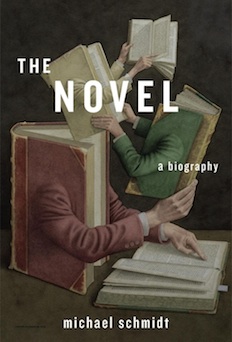By Lewis Fried
This is a massive and distinguished work. It is much more than a chronological account of the development of the novel. Schmidt does not push a thesis; instead, The Novel presents the relationships amongst works and their reception by writers themselves. Quoting Ford Madox Ford, Schmidt is interested in the assessments of works by “‘artist-practitioners,’” namely people “‘who love their arts as they practice them.’“ In Schmidt’s words, “The most penetrating insights into Cervantes are those of Fielding, Smollett, and Sterne, of Stendhal and Flaubert and Turgenev, Dickens and Faulkner and Hunter S. Thompson: not only what they say about Don Quixote, but how they incorporate the sad knight and his sidekick into their own imaginations.” This blurs the lines among influence, inspiration, and just plain attractiveness. And, what writers assess and judge is not always an example of a most penetrating insight. However, Schmidt’s culling of opinion and wide focus display an extraordinary command of literary development. In fact, the reader will have to ask, “Is there any major writer that Schmidt has not discussed?”
Of course, the answer is yes (I had hoped that he would have added a section on Middle-Eastern as well as Asian writers), but the question itself is unhelpful, leading to a scrivener’s quarrel in the light of what The Novel does explore. After all, how many writers can one confidently place in a group? How much does one have to research? Analogously, we should keep in mind Tolstoy’s moral, which is the question that the title of his short story presents: how much land does one need? Unlike Middlemarch’s Mr. Casaubon, endlessly searching for the key to all mythologies, Schmidt finishes his work well-made, in a humanly and timely fashion. It’s well to remember Koheleth’s observation that “there is no end to the writing of books.”
The Novel begins with Mandeville’s Travels (although written in French, the narrator is English) and concludes with Martin Amis. The chapters deal with novels, later presented in selected groups, under conceptual rubrics that range through formal and intellectual innovation (“Literature as Invention”; “The Fate of Form”; “Genre”; and “Pariahs” to cite several of the 45 chapters ). The history of the novel is in process itself, of colloquy, transformation and tradition. It engages what has come before it, as well as disputing such. Unsurprisingly, the clusters of works can be debated, but Schmidt makes a case (strong or weak is up to the reader’s judgment) for connecting the authors he selects. As he writes, “The organization of chapters in the second half of the book is hard to explain from the outside…The writers came together in configurations that seemed to me expressive: there was a dialogue between them or their works.” In chapter after chapter, these groups, and associations reveal both a literary history as well as Schmidt’s capacity for selective association, making The Novel unabashedly subjective, instructive, and a good walk unspoiled. In order to read his book, one has to surrender to Schmidt’s groupings, wondering what comes up next. In each chapter there is much “back and forth” and surprise; for this reader, The Novel is an arabesque in which a line of examination is curved, swirled, and elaborated on not merely on one axis but on several. In other words, to read this work, you have to “go with the flow.”
How to assess The Novel is another question. Is it reducible to a study of literary kinship? Or more intriguingly, a work making a case for devaluing scholarly writing? In what manner is a section organized? So, for instance, in an interesting section on Coetzee, we move from the South African novelist’s Foe to his In the Heart of the Country, to Coetzee’s essay on Kafka, to Caryl Phillips study of Coetzee, to Nadine Gordimer on Coetzee, and back to Coetzee’s novels, with scattered observations on the novelist’s life. I have to admit I found coherence and presentation, as well as analysis, variable from section to section. Schmidt writes out of the joy of discovery and the discovery of joy. As he puts it, “A novel is a kind of rabbit hole….Our developing habit [of reading novels] requires increasingly subtle stimuli and satisfactions—a hunger for experience transformed [sic], that transformation being the writer’s aim. Climaxes, epiphanies, metamorphoses are in the nature of story telling, from fairy tale and ballad to Finnegan’s Wake.” These last terms can easily be applied to The Novel. Add engaging, lucid, and strong.
Lewis Fried (ΦBK, Queen’s College, CUNY, 1964) is Professor of English Emeritus at Kent State University and a resident member of the Nu of Ohio chapter of Phi Beta Kappa.




